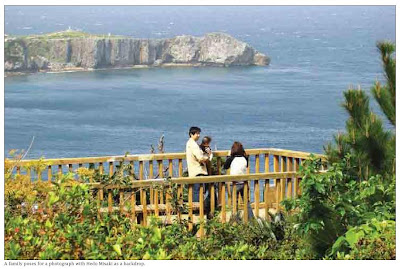
I’ve been hearing about how they have dragon boat races here on Okinawa. Can you tell me a little bit about them? Are they the same as the ones in Hong Kong?
— Noah J. Smith
There are several popular Chinese legends that depict water dragons as quasi-demigods that govern the rivers, seas, and oceans. And every year, during the spring and summer months, these legends come to life in the waters surrounding the island of Okinawa.
Most agree that dragon boat races originated in China, and were either brought to the island as a form of entertainment for visiting Chinese envoys, or were transferred to the Ryukyu Kingdom by islanders who saw the spectacle while visiting or studying in China. One of the most popular legends about the beginning of dragon boat racing is the story of Chu Yuan—a faithful member of a 278 B.C. Chinese emperor’s court.
ChuYuan was a poet and philosopher, and while many in the government respected Yuan (and usually heeded his sage counsel), they adored playing their political court games too much. Yuan worked long and hard for reforms to save the ailing empire. However, it wasn’t long before the emperor was beguiled by silver-tongued sycophants and ChuYuan was banished from the court.
While in exile, Chu Yuan composed poetry about his fervent love for his country, and his deep concern for his homeland’s future. He made friends among the rural populace, especially with the fishermen.
However, upon learning of the devastation of the court at the hands of a rival kingdom, Chu Yuan fell into a bleak depression. And, because he felt somehow responsible, he leaped into the Mi Lo River holding a great rock.
Many fishermen raced out in their boats in an attempt to save Chu Yuan while beating on drums and splashing their oars in the water to keep the water dragons away from his body. Although many boats were dispatched to save him, none were fast enough, It is said that the dragon boat races throughout Asia were originally held in honor of this statesman.
Today, dragon boat races are held in fishing communities throughout Okinawa beginning in the late spring and lasting through late summer. The largest of these festivals is the Naha HárI (also known as Harii) which is held during Golden Week, five days of holiday between April 29 and May 5. Naha’s dragon boat races, which will take place May 3 to 5, pit large multi-colored boats against each other in breathless sprints. Each vessel is powered by a 32-rower team and decorated with ferocious- looking dragon heads, scaled arms with sharp talons, and elaborate tails.
Teams range from those made up of district residents, groups comprised of company employees, and rowers from different countries (including teams from U.S. military installations). The three-day Naha Hâri Festival often draws hundreds of thousands of spectators and incorporates food booths, live band performances, and nightly firework displays.
Regardless of origin, dragon boat races remain immensely popular on Okinawa. The races have changed considerably over the centuries: today many of the ancient symbolic rituals of veneration are overshadowed by the entertaining spectacle. However, almost everyone who has witnessed or participated in a race will probably attest to this—during hâri season, water dragons do indeed rule the seas of Okinawa.
—Mike Daley
Got questions for Mike? E-mail editor@okinawa.usmc-mccs.org.
















































